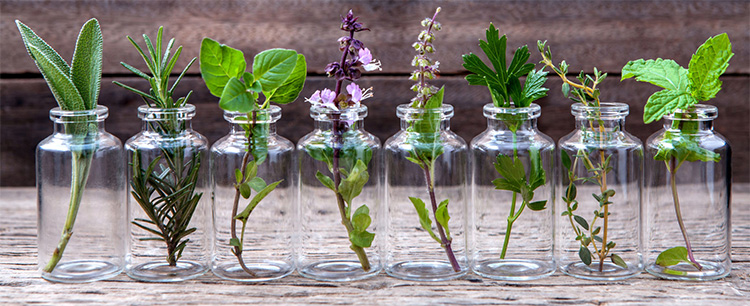Hydrosol Shelf Life and Storage Tips

Unlike essential oils, hydrosols are water-based. As a general rule of thumb, hydrosols possess a shorter shelf life than do their essential oil counterparts.
Hydrosol Shelf Life
The shelf life of a hydrosol depends on the specific botanical of the hydrosol, its pH level, the conditions and details of its distillation, the storage conditions of the hydrosol after distillation and how it's bottled and handled. In some cases, alcohol or another preservation agent is added by suppliers to prolong its shelf life. Unless a supplier clearly states the contents of its hydrosols, be sure to ask for clarification.
Each of the hydrosols profiled on AromaWeb lists the typical shelf life of the hydrosol. The listed shelf life is an approximation and the above factors can all play a huge part in impacting the ultimate shelf life of any given hydrosol.
Storage Location
Ideally, hydrosols should be stored in the refrigerator. If you don't have room in your fridge, keep your hydrosols stored in a dark location that is kept at a cool, consistent temperature.
pH Levels
Testing and recording the pH level of a hydrosol at the time of purchase/receipt can be helpful in assessing the condition of the hydrosol as time passes. Changes in the pH over time can be an indication that the hydrosol has become contaminated.
Suzanne Catty says: "Generally hydrosols with a pH of 5.0 or less last longer than hydrosols with a pH over 5.0. As a very broad rule of thumb, I rate those under 5.0 pH at two years and over 5.0 pH at twelve to eighteen months." [Suzanne Catty, Hydrosols: The Next Aromatherapy (Rochester, VT: Healing Arts Press, 2001), 147.]
Within Hydrosols: The Next Aromatherapy, Catty provides a great deal of information on the typical pH level of particular hydrosols and gives insight on how to use pH values to determine the condition of a particular hydrosol, how to filter hydrosols to remove unwanted substances and to prolong shelf life.
Hydrosol Bottling
Ann Harman, expert hydrosol distiller and author of Harvest to Hydrosol recommends storing hydrosols in clear glass bottles when possible. Although it is recommended that essential oils be stored in dark glass bottles, Ann explains that storing hydrosols in clear glass allows you to monitor for blooms (see below section) or any other changes in the hydrosol. [Ann Harman, Harvest to Hydrosol (Fruitland, WA: botANNicals, 2015), 84.]
In many cases, suppliers ship hydrosols in plastic to prevent glass breakage during transit. Glass is heavier than plastic and can also increase shipping costs.
Some reputable hydrosol suppliers package their smaller size hydrosols in plastic sprayer bottles to save on the cost and risks of shipping glass while simultaneously offering the convenience of a sprayer top. For small quantities of hydrosols that will be used up quickly, purchasing and storing your hydrosols in plastic (i.e. HDPE plastic bottles with sprayer tops) is fine.
In Harvest to Hydrosol, Ann Harman urges "If you must store in plastic containers, try to use ether HDPE, high-density polyethylene, or one of the wine industries' 'bag in box.' Keep in mind that HDPE will, over time, absorb the essential oils fro the hydrosol. [Ann Harman, Harvest to Hydrosol (Fruitland, WA: botANNicals, 2015), 84.]
For those interested in the vibrational and energetic properties of hydrosols, Suzanne Catty offers some interesting information about violet bottles and bottles made with true cobalt. [Suzanne Catty, Hydrosols: The Next Aromatherapy (Rochester, VT: Healing Arts Press, 2001), 167.]
Look to the Bottles and Packaging section of AromaWeb's Global Aromatherapy Business Directory for bottle suppliers. Each supplier can assist you in choosing glass or HDPE plastic bottles that are suitable for hydrosol storage.
Be sure that the bottles that you choose to use are clean and sterile.
Make it a habit to always tighten the caps on your bottles well. You don't need them to be so tight that you risk breaking the cap.
Headspace
Over time, oxygen can be an enemy to hydrosols. Headspace is the amount of empty space within a bottle of hydrosol. Reducing headspace reduces the amount of oxygen that can react over time with the hydrosol. If you have a bottle of hydrosol with a lot of headspace, transfer the hydrosol to a smaller bottle.
Keep Hydrosols Free of Contaminants
To prolong the shelf life of your hydrosols and keep harmful bacteria out, refrain from allowing your hands, skin, nose, cottonball or other substances from coming into contact with your primary bottle of the hydrosol. Instead, pour a small quantity of hydrosol into a smaller bottle and work with that tiny quantity. That will ensure that your main supply is kept sterile.
Blooming Hydrosols
Contaminated, aging hydrosols can sometimes grow a bloom. Although dark glass is the ideal bottle type for essential oils, dark or opaque bottles can make it more difficult to see a hydrosol bloom. As mentioned in the Hydrosol Bottling section above, storing hydrosols in clear glass makes it easier to spot blooming hydrosols.
A bloom is a ghost-like, swirling substances that can be seen towards the bottom of a hydrosol that has aged or is going off. If you gently lift a bottle of hydrosol to eye level and gently move the bottle slightly, you can see the bloom dance.
Ann Harman advises that "Once a hydrosol has gone off, or bloomed, it should not be used therapeutically or internally... Simply filtering out the bloom with a coffee filter or such does not remove this waste from the hydrosol." [Ann Harman, Harvest to Hydrosol (Fruitland, WA: botANNicals, 2015), 86-87.]
For more information about blooms, contamination, particulates, please refer to Harvest to Hydrosol.
